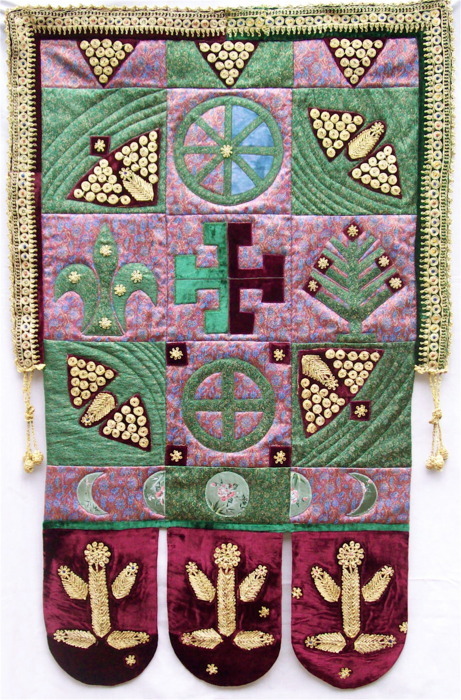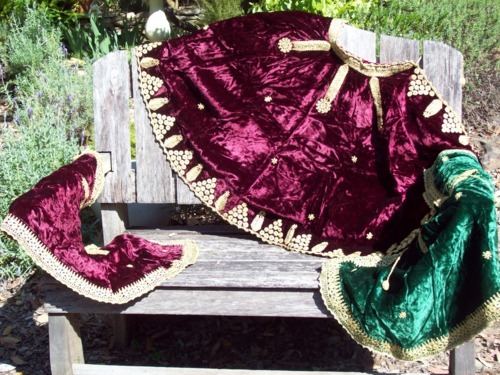Below are some of the concepts that relate to the symbols incorporated into Nickie’s quilt. Each symbol tends to overlap and interweave with others – as all aspects of every story do.
The central focus of the quilt is the Celtic cross, sharing the two colours of the velvet capes, red and green. This is surrounded by four symbols that represent the foundational relationships in Nickie’s journey: the family relationships between father, mother, Nickie and her sister.
The Wheel symbol, at the top of the cross is also the Wheel of the Year and a Celtic symbol of the life cycle according to the eight seasons, as they were experienced. At the bottom of the cross there is the Cruciate form - a cross of equal lengths enclosed by a circle, a symbol of Creation, cosmic union, initially through the union of male and female; and of the four directions of the Earth meeting at the centre, being surrounded and embraced by the round of Earth’s horizon. I have also read that gypsies adopted the form as both a symbolic of sexual union. In practical ways, the two elements of the symbol were used to mark a horse’s right foreleg with a cross (male) and its left foreleg with a circle (female), on the understanding that the two symbols would attract each other, thereby keeping the horse ‘hobbled’ so as not to run away (Walker p.46).
Nickie’s sister has been involved in the Australian Scouts movement all her life – hence the Fleur-de-lys with the Southern Cross, made from the little stars sewn over the original capes. Another interesting aspect of the fleur-de-lys is that it has Goddess associations, and has been used in imagery of the Mary, Mother of Jesus, whose power as the Virgin aspect of the Triple Goddess (Virgin, Mother, and Crone) was to conceive and give life to the Godhead. By extension it also refers to the power to re-birth self – both occurrences occurring parthenogenetically, that is, unassisted by male intervention (Walker p.426).
On the complementary right arm of the bigger Celtic cross is another creation symbol of regeneration and ‘the source of unborn souls’, as it gave shelter in the afterlife. It also contains the element of ‘sacrifice’, meaning being made sacred through undergoing/accepting ‘all that Life has to offer’ thereby maintaining the life-force embodied in the World Tree, which was always assigned female gender and regarded as the all-nourishing Mother. In India and Persia, the Tree was depicted with 5 branches, symbolising the 5 elements: earth, air, fire, water and ether (Walker p.472). It can be understood as representing the experiences we have had of healing and being healed: ass Nickie says, ‘learning to embrace all that Life has to offer’.
In each of the four corners there is a ‘sprite’, faerie or angel, providing protection and energy that flows to and from the four directions. These designs were formed by combining elements from the borders of Nickie’s mother’s cape, and celebrates Nickie’s healing powers. Below this there is a panel showing the phases of the moon, waxing from the left into fullness at the centre and waning to darkness on the right. The moon is sacred to Goddess symbolism and ritual. The three dancing Goddesses beneath celebrate their power as creativity and innocence (Virgin), the fertility to give and nurture (Mother), and to renew life (the Wise Old One).
Creating with the fabrics
The symbols on these nine blocks were appliquéd using fine machine satin stitch, using the fabrics alternatively from the green and pink dresses. The surround of the quilt is made from the beautiful, heavily embroidered borders of the two little capes belonging to the two sisters, again combining the green and the red, and the tassles are from each of the 3 capes. I tied them with a loose knot, because the knot is also sacred to the Goddess as weaver-creator; and gypsy women untied knots/braids to assist childbirth (Walker pp. 130, 142). Those on the quilt can be undone, of course – and can be re-made ritually according to need.
Reference: Walker, B, 1988, The woman’s dictionary of symbols & sacred objects, Harper & Row, NY

